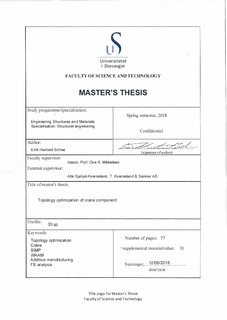| dc.contributor.advisor | Mikkelsen, Ove | |
| dc.contributor.author | Hartveit-Schee, Eirik | |
| dc.date.accessioned | 2018-09-12T11:43:16Z | |
| dc.date.available | 2018-09-12T11:43:16Z | |
| dc.date.issued | 2018-06 | |
| dc.identifier.uri | http://hdl.handle.net/11250/2562225 | |
| dc.description | Master's thesis in Structural engineering | nb_NO |
| dc.description.abstract | Topology optimization is an important tool for conceptual design of products.
Finite element based topology optimization formulations, such as the Solid Isometric
Material with Penalization (SIMP), have proved to be a solid algorithm
for finding optimized geometries and have become widely implemented in commercial
Computer Assisted Design (CAD) software. When topology optimization
is viewed in conjunction with additive manufacturing (3D-printing), because
of it's increased shape forming capabilities, highly optimized parts can be
achieved. Technologies for 3D-printing large, metallic, load bearing structures is
still in early development, but shows great promise, like the Wire Arc Additive
Manufacturing (WAAM) method. These methods display advantages in other
areas, such as material effciency and fast deposition rate, that differentiate them
from other, established 3D-printing methods.
Topology optimization was used to develop two conceptual designs of reduced
volume compared to original component, which was an end truck of a over head
crane system developed by T. Kverneland & Sønner AS (TKS). One design
intended for traditional manufacture and one intended for additive manufacture.
Both proposed designs showed Von Mises stress above yield strength at certain
areas of the model. Sharp corners and narrow radii of hole pro les were the
main reason for this. Also, for the additive manufacture design, thin members
were observed with high stress values. Designs could be improved by round-off of sharp corners, increasing radii of hole profiles and increasing thickness of
thin members. It is believed that viable design can be achieved without drastic
changes to the designs proposed in this thesis. Proposed design for traditional
and additive manufacturing have a volume reduction of 17% and 14% respectfully
relative to volume of original component. | nb_NO |
| dc.language.iso | eng | nb_NO |
| dc.publisher | University of Stavanger, Norway | nb_NO |
| dc.relation.ispartofseries | Masteroppgave/UIS-TN-IMBM/2018; | |
| dc.rights | Navngivelse 4.0 Internasjonal | * |
| dc.rights.uri | http://creativecommons.org/licenses/by/4.0/deed.no | * |
| dc.subject | materialteknologi | nb_NO |
| dc.subject | byggkonstruksjon | nb_NO |
| dc.subject | topology optimization | nb_NO |
| dc.subject | SIMP | nb_NO |
| dc.subject | crane | nb_NO |
| dc.subject | WAAM | nb_NO |
| dc.subject | additive manufacturing | nb_NO |
| dc.subject | FE analysis | nb_NO |
| dc.title | Topology optimization of crane component | nb_NO |
| dc.type | Master thesis | nb_NO |
| dc.subject.nsi | VDP::Teknologi: 500::Bygningsfag: 530::Konstruksjonsteknologi: 533 | nb_NO |

